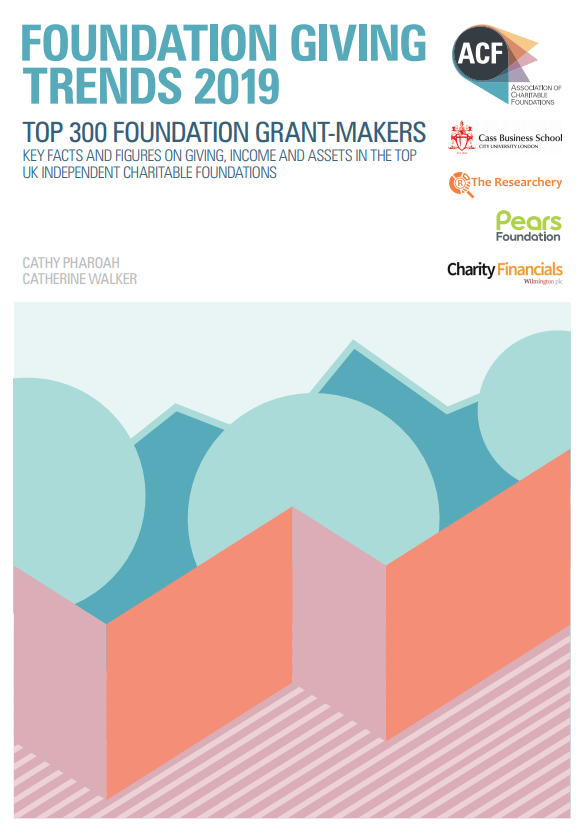Foundation Giving Trends 2019
by Emma Hutchins, ACF
How do you measure a sector that isn’t defined? This is the challenge we meet each year when we produce Foundation Giving Trends, studying the foundation landscape in the UK.
With an estimated 12,000 registered grant-making charities, focusing on the top 300 may seem like the tip of the iceberg. In many ways, it is; there’s a huge number of smaller trusts doing vital work with a much smaller grants budgets across the country, not to mention the many other charities that make grants as a secondary activity. But when it comes to the value of giving, it is estimated that the top 300 foundations make up around 90% of the total.
With no legal definition of a foundation in the UK, it’s a challenge in itself to develop a methodology that includes organisations we recognise as ‘foundations’ and excludes those we don’t. At present, the report focuses on independent philanthropically-funded foundations whose principal activity is grant-making. While this definition is not perfect, it provides sufficient clarity for a point of reference against which we can discuss, debate, and dispute.
These complexities are among the reasons that Foundation Giving Trends makes for such an interesting read. Carried out by Professor Cathy Pharoah and Dr Catherine Walker, generously supported by Pears Foundation, the series presents annual research and analysis on trends in the giving, spending, income and assets of the top 300 foundations as defined in the report. As well as offering a snapshot for the year, it draws comparisons against previous years, allowing us a thorough understanding of trends and foundation sector responses to external events over time.

The picture on assets is an example of the value in comparing year to year. With collective asset value reaching a new high point of £67bn, the picture emerging from this year’s data suggests a positive one. But when we look at the trends in assets over a period of time, we see that growth rate has slowed to 1.8% (and -1.1% if we exclude the huge Wellcome Trust, which on its own accounts for a third of the sector’s money). The trend towards slowing asset growth, a result of uncertainty and market volatility, is one to monitor and demonstrates the importance of looking at annual snapshots in a longitudinal context.
Uncertainty and volatility also affected income in 2017/18. After robust growth the previous year, income fell by 1.7% following negative growth in investment income (-5.9%) and negligible growth in voluntary income (0.1%). Income in the current year can be an indicator of grant-making in the next, and so this data can help us to understand and prepare for what may be around the corner.
It would be misleading though to paint 2017/18 as a bleak year for foundations, particularly when it comes to grant-making. Foundation giving among the top 300 was £2.9bn, and grew by almost 10% when Wellcome Trust is excluded. Two thirds of the top 300 made a real terms increase in their grant-making, and most of these did so in the face of a dip in their own income, assets, or both.
This all goes to show that the foundation model is resilient and responsive. In the face of emerging and persistent issues and increasing demand on resources – coupled with a decline in grants from government – foundations have dug into their own reserves and capital in an effort to meet need.
It also tells us that the foundation model is not immune from external factors. Their independence, flexibility and longevity make foundations unique in society, but they too are affected by changes in the political, economic and social environment. We see this play out as foundations pursue new and creative ways to continue being relevant in the changing world around them.
Having this sound evidence base is vital and underpins our understanding of the foundation sector. It also presents a number of opportunities.
A common critique of foundations is their lack of transparency. Foundation Giving Trends gives us useful insight into the size, scale and fortunes of the UK’s largest foundations, opening up the foundation sector not just to the general public but importantly to others within the foundation community, who can compare and contrast with their peers.
This comparison among foundations means the evidence serves a second purpose: encouraging more and better giving. By presenting the top 300 as a table, we often see and hear foundations looking carefully at their own position in the list and using it as a benchmark to see if their own giving could increase to boost their ranking.
Beyond the foundation sector, the evidence enables an informed case in policy-making to support the value of foundations’ contribution. With giving just under £3bn, foundations are a valuable source of funding for social good. But given that this equates to just 0.5% of total government spending, foundations are not a replacement or subsidy for the state. Having the evidence base of the scale and nature of foundations’ contribution is essential in making this case.
So, to answer the question we started with, how do you measure a sector that isn’t defined? While we can measure giving, income and assets, the real value is in how the research helps us answer questions about issues that cannot be so readily measured. How do foundations respond to change? How are foundations meeting the challenges posed by the climate crisis, public scrutiny and political and economic turbulence? How can foundations give more and better? Foundation Giving Trends 2019 is a crucial tool in helping us answer these questions.
by Emma Hutchins, ACF

Emma Hutchins is ACF’s Policy & Communications Manager, having joined the association in 2016. Emma is responsible for the day-to-day activities of ACF’s policy function, including leading the Members’ Policy Forum and contributing to the Stronger Foundations initiative. Prior to working for ACF, Emma studied an MA in International Relations and Gender at the University of Birmingham. Emma has also worked as a fundraiser for a small international peacebuilding charity, and volunteers with a local charity that brings together younger and older people living in her borough.
